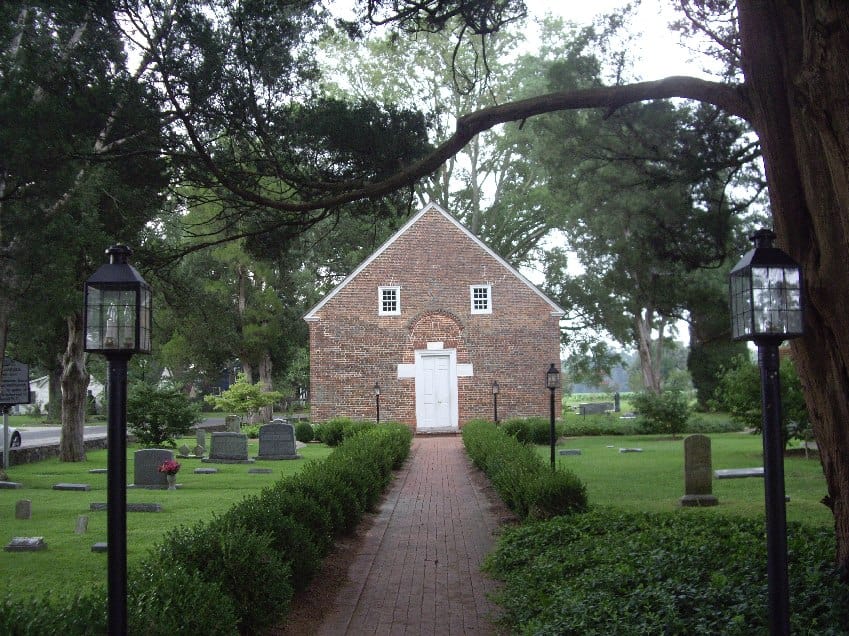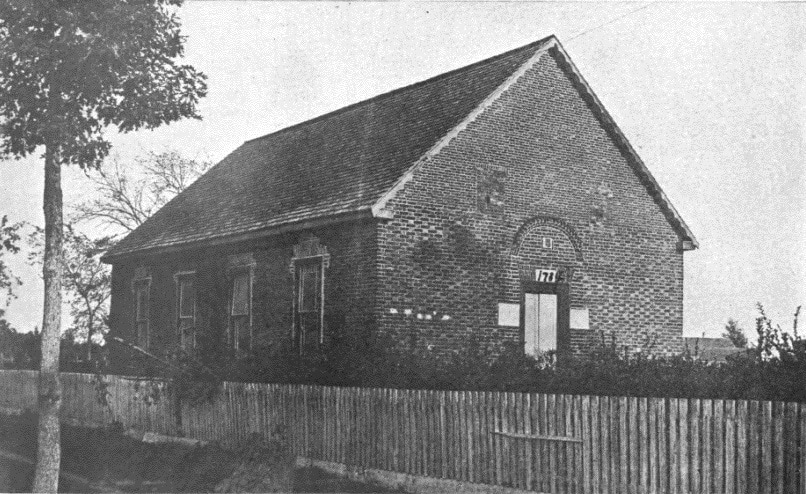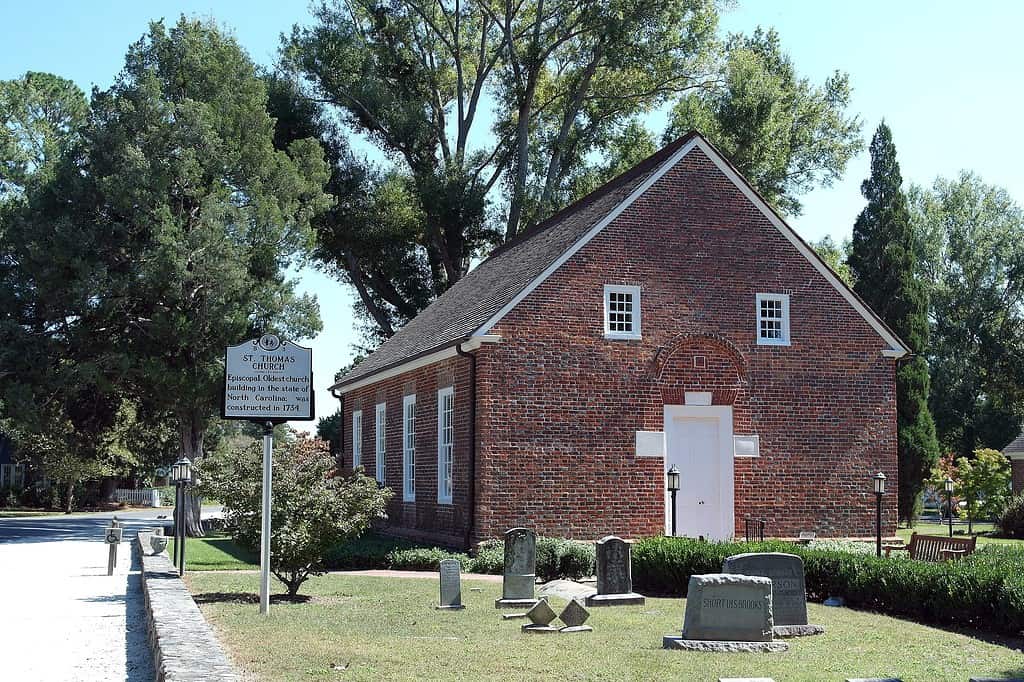The oldest church in North Carolina has survived more than 300 years and still holds weekly services in the original building. The historic parish was a cornerstone in the town that bloomed around it at the turn of the 18th century. Today, the church and the surrounding conservative town offer a quiet place to visit while traveling along the Pamlico River. Keep reading to learn more about the oldest church in North Carolina and its rich history.
What Is the Oldest Church in North Carolina?

The oldest church in North Carolina is in the small town of Bath.
©Charlottewitch1 / CC BY-SA 4.0 – License
The oldest church in North Carolina is the St. Thomas Episcopal Church. The historic building is located in the small town of Bath, the oldest town in the state. Bath was created from the European settlement along the Pamlico River in the 1690s, becoming North Carolina’s first town in 1705. The St. Thomas Episcopal Church was built in 1734 and continues to hold Sunday and holiday services. The active parish welcomes new members and visitors interested in learning more about its history.
History of the St. Thomas Episcopal Church

The St. Thomas parish predates the incorporation of Bath.
©Southern Churchman Co. / CC BY-SA 4.0 – License
The history of the oldest church in North Carolina dates back over 300 years, predating the town’s conception. Bath County was established in 1696, with the St. Thomas Parish following suit shortly after. Within four years, Reverend Thomas Bray worked with Reverend Daniel Brett to create the colony’s first public library. The parish held services for many years until the church building was built. In fact, services were held within the homes of the parish members.
The St. Thomas Episcopal Church became one of five parishes in the colony due to the Vestry Act of 1701. However, it took until 1823 for the church’s acceptance into the Diocese of North Carolina. It was later consecrated in 1826. Then in 1840, a ferocious hurricane destroyed the building’s roof and much of its interior. Many Victorian-styled furniture pieces from the remodel remain today.
The Garzia Building, built in 1866, sits south of the church. It was once the parish hall but is now the sacristy. The Garzia Building is named after Reverend John Garzia, an Anglican minister from Spain who served the parish from 1733 to 1744. He came to Bath in 1733 from Virginia to oversee the church’s construction.
In 1936, Reverend A.C.D. Noe and Robert B. Davis started planning the church’s preservation and restoration project. The process began in 1939, highlighting the historic building’s role in the town. As a result, the Parish Hall is dedicated to A.C.D. Noe to honor his efforts, bearing the name A.C.D. Noe Building.
Significant Events at the St. Thomas Episcopal Church

Famous pirates like Blackbeard took up residence not too far from the church.
©Tradewinds / CC BY-SA 3.0 – License
Bath was the “St. Thomas parish in Pamlico” before it was incorporated. Thomas Bray, the English Anglican clergyman, promoter of the Church of England, and the founder of the Society for the Propagation of the Gospel in Foreign Parts (S.P.G.), created the church’s library. The collection contained more than 1,050 books and pamphlets to help clergymen in the American colonies instruct their delegations.
The oldest church in North Carolina is nearly yards away from Bath Creek on the mouth of Pamlico River, a tributary to the Atlantic Ocean. Bath was a vital port town for the Carolina colonies in the 18th century. Ships, some of which belonged to famous pirates like Blackbeard, sold their wares and took a break from sailing the open water. Bath was an easy-going town because of its association with partying and harboring pirates.
George Whitefield, a strict and traveling evangelist, disagreed with how some American colonies led their services. His claim to fame is his passionate sermons that depicted hellfire and damnation. His sermons and those he inspired were part of “The Great Awakening.” This religious revival swept through the English colonies in America, particularly affecting Protestant denominations.
Bath’s reputation brought Whitefield to town. His presence was unwelcome, and he cursed the town, darkening the door of St. Thomas Episcopal Church. He allegedly waved his shoes in the air at a crowd made up of the delegation and other town members. Shortly after that, Bath’s prosperity slowly dwindled. By the late 19th century, it returned to a sleepy waterfront town. Whitefield believed his curse was successful.
Artifacts You Can Find in the Oldest Church in North Carolina
Unsurprisingly, a building over three centuries old has collected its fair share of artifacts. In addition to the Columbarium and graveyard dotted with tombstones, several treasured items give us a glimpse into the rich history of the oldest church in North Carolina.
The most notable artifacts in the St. Thomas Episcopal Church include:
- Queen Anne’s Bell. The bell was purchased through Queen Anne’s Bounty and was cast in England in 1732, making it older than the Liberty Bell. You can find it between the church and the Garzia Building.
- The silver chalice given to Rev. Garzia from the Bishop of London in 1738.
- A silver candelabra from King George II dating back to 1740.
- A slate tablet honoring the Col. Robert Palmer’s wife, Margaret. She died in Bath in 1765.
Wildlife Near the Oldest Church in North Carolina

The eastern
tiger
swallowtail is one of North Carolina’s state animals.
©Maria T Hoffman/Shutterstock.com
The waterfront town of Bath is home to many animals. You can see abundant wildlife on the water, including dolphins, crabs, flounder, striped bass, and speckled trout. But on land, it’s common to see animals like the eastern gray squirrel, red-cockaded woodpecker, and the snapping turtle. If you look closely at the ground or the shrubby surrounding the oldest church in North Carolina, you’ll see different types of lizards, including the eastern glass lizard. Additionally, you may see a northern cardinal or an eastern tiger swallowtail flying through the air.
The photo featured at the top of this post is © Tradewinds / CC BY-SA 3.0 – License / Original
Thank you for reading! Have some feedback for us? Contact the AZ Animals editorial team.






